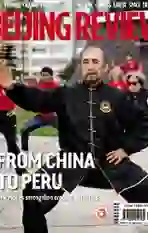CULTURAL FUSION
2016-12-22ByJiJing&LuYan
By+Ji+Jing+&+Lu+Yan

The Peruvian version of Chinese President Xi Jinpings The Governance of China was released in Lima, capital of Peru, on November 19. The local version was jointly published by Chinas Foreign Languages Press (FLP) and Perus Editora Peru.
The book is a collection of 79 of Xis speeches, talks, interviews, instructions and correspondence. The FLP originally published the works in a number of languages, including Chinese, English, Russian, Arabic, French and Spanish, in September 2014. Over 6.2 million copies have since been distributed, some 500,000 of which have been circulated in more than 100 countries and regions.
Huang Kunming, Executive Deputy Director of the Publicity Department of the Central Committee of the Communist Party of China, said the book is a gateway for local readers to know about the Chinese presidents concepts, thoughts and strategies of national governance.
The book will contribute to mutual understanding between Peru and China—two countries with different cultures and political traditions, said Zhou Mingwei, President of China International Publishing Group, a Chinese media conglomerate whose subsidiaries include the FLP.
Carlos Becerra Gutierrez, Chairman of the Board of Editora Peru, said that he believes many of the theories expounded in the book can also be applied in Peru.
This is only one of the examples of the friendly cultural exchanges between Latin American countries and China—President Xi toured South America in November, attending the 2016 APEC meeting in Peru along the way.
Big celebrations
The opening ceremony of the China-Latin America and Caribbean 2016 Year of Cultural Exchange, the biggest-ever cultural exchange program between the two parties, was held at the Beijing Tianqiao Performing Arts Center on March 24. The program features nearly 30 Latin American and Caribbean countries and their contributions to literature, media, art and travel.
About eight months later, on November 21, the cultural exchange programs closing ceremony was held at Perus National Museum of Archaeology, Anthropology and History in Lima. President Xi and his wife Peng Liyuan were warmly welcomed by Perus President, Pedro Pablo Kuczynski, and his wife Nancy Lange. After the ceremony, the two couples browsed an exhibition of 121 selected artifacts spanning over 5,000 years of Chinese civilization.
Xi noted that China and Latin America and Caribbean countries share similar experiences, having long histories and splendid cultures as well as having suffered from foreign invasion and social instability. Now, the two sides are devoted to the cause of developing their economies and improving their peoples wellbeing.
More cooperation
The increasingly frequent high-level visits and economic and cultural collaboration have enabled the steady development of the bilateral relations in various areas.
In April 2009, China and Peru signed a Free Trade Agreement. Since then, China has become Perus largest trading partner and largest export market. The two countries maintain increasing exchanges in the fields of culture, science, education and tourism.
On November 20, the Chinese Book Center was unveiled in the National Library of Peru. The center was co-established by China International Publishing Group and the National Library of Peru and is the very first in South America, aiming at providing local people with an access to Chinese culture and civilization.
On the same day, China Today, the only Spanish-language monthly magazine published in China since the 1960s, launched a special issue in the National Library of Peru in Lima, commemorating the 45th anniversary of the establishment of diplomatic relations between the two countries.
“Cultural exchanges make the two peoples feel closer, which will lead to mutual trust,” Guo Cunhai, associate researcher at the Institute of Latin America under the Chinese Academy of Social Sciences, said in an interview with Xinhua News Agency. Guo also believes that increased mutual interest will benefit the two sides in terms of the economy and trade, elevate the quality of their cooperation, and further push forward the sustainable development of bilateral ties. “This is the most important aspect of the China-Latin America Year of Cultural Exchange.”
